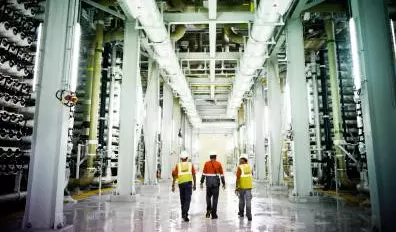Veolia controls all the stages of the water cycle and can meet the many challenges of local authorities and industrial customers: resource management, production and delivery of drinking water and industrial process water, collection, treatment and recycling of wastewater from all sources as well as by-products from its treatment (organic matter, salts, metals, complex molecules and energy), customer relationship management, as well as the design and construction of treatment and network infrastructure.
Water traceability is at the heart of the Group's concerns, which ensures the preservation of drinking water quality, from the plant up to the distribution to the consumer.
The quality of collected effluents is also continuously monitored to optimize the efficiency of processes implemented in the treatment plants operated by the Group.
Water treatment
Beyond the design, construction and operation of treatment plants, Veolia has a portfolio of over 350 proprietary technologies to address the water management issues of communities and industrial customers:
Production of drinking water and industrial process water (including production of ultrapure water, seawater desalination and treatment of new pollutants) and the treatment and recycling of wastewater of all kinds, including the treatment and recovery of waste (organic matter, salts, metals, complex molecules and energy), using innovative solutions to produce reagents, green energy, fertilizers and even bioplastics.
Customer relationship
Veolia has developed a number of tools serving customer relationship, which adapt to the needs of local authorities and simplify the formalities to be completed by customers.
The Group has also established customer relationship centers and local customer support centers to assist customers. They have access to web portals and mobile applications to complete their formalities and receive information online.

- Integrated control centers monitor the status of services in real time and relay any anomalies to the customer relationship centers which then schedule work in the field.
- An energy management system monitors the consumption of "water" facilities operated by the Group and identifies the areas requiring optimization.
Veolia has also developed an 'e-monitoring' service that allows individuals, local authorities and industrial customers to better control their consumption.
Veolia Water Technologies, which is a subsidiary of Veolia, combines technologies and engineering services to offer a comprehensive range of water treatment solutions. Veolia Water Technologies delivers turnkey solutions to local authorities and industrial customers, such as plants producing drinking water, process water or ultra-pure water, seawater desalination plants and treatment and recovery systems for wastewater and the waste generated, in compliance with the environmental regulations in force.



